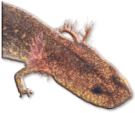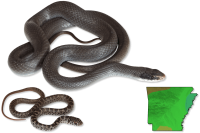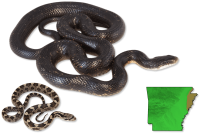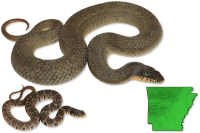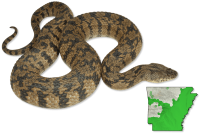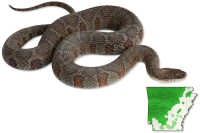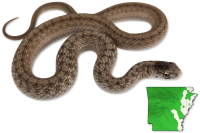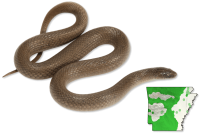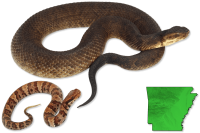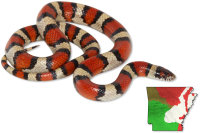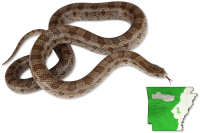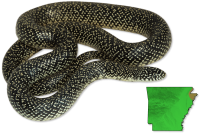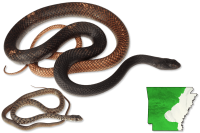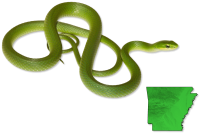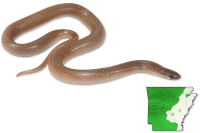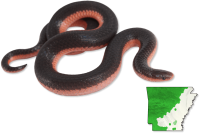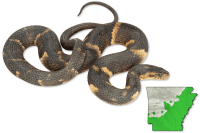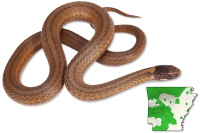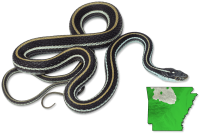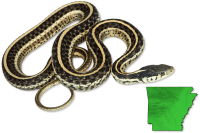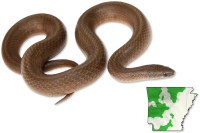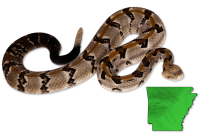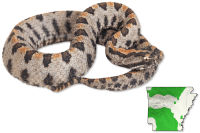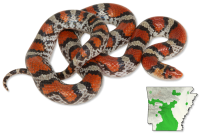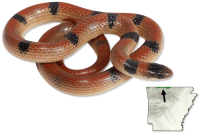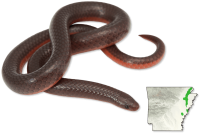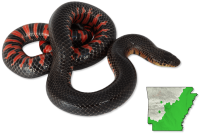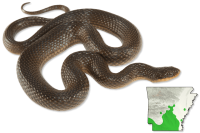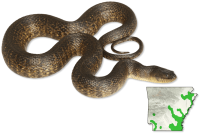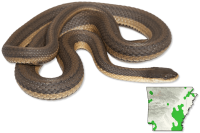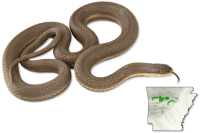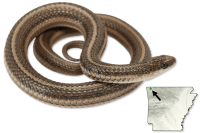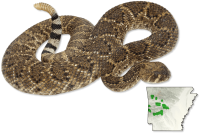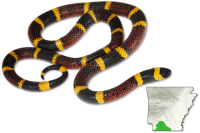Most Common IDs
Southern Black Racer - Coluber constrictor priapus : nonvenomous >> common fast slender black snake — juveniles with blotched patterning — preys on a wide variety of animals, including birds, frogs, and even other snakes — sometimes will climb into trees
https://herpsofarkansas.com/reptiles/snakes/coluber-constrictor/Western Ratsnake - Pantherophis obsoletus : nonvenomous >> common black snake — juveniles with blotched patterning — preys on small rodents and birds by constriction, but with strong appetite for bird eggs — good climber
https://herpsofarkansas.com/reptiles/snakes/pantherophis-obsoletus/
https://www.facebook.com/groups/ratsnake/
https://www.facebook.com/groups/183804562168447/Plain-bellied Watersnake - Nerodia erythrogaster : nonvenomous >> common watersnake, generally more associated with still waters, but prone to wander upland — juveniles more boldly patterned — preys mostly on fish and frogs
https://herpsofarkansas.com/reptiles/snakes/nerodia-erythrogaster/Diamond-backed Watersnake - Nerodia rhombifer : nonvenomous >> common large-bodied watersnake generally associated with big waters, such as lakes and rivers — preys mostly on fish
https://herpsofarkansas.com/reptiles/snakes/nerodia-rhombifer/Midland Watersnake - Nerodia sipedon pleuralis : nonvenomous >> common watersnake generally associated with upland rocky streams — preys mostly on fish and frogs
https://herpsofarkansas.com/reptiles/snakes/nerodia-sipedon/Dekay's Brownsnake - Storeria dekayi : nonvenomous >> common small fossorial "yard snake" — preys mostly on soft-bodied invertebrates, especially slugs and snails
https://herpsofarkansas.com/reptiles/snakes/storeria-dekayi/Rough Earthsnake - Virginia striatula : nonvenomous >> common small fossorial "yard snake" — preys mostly on small soft-bodied invertebrates, such as earthworms
https://herpsofarkansas.com/reptiles/snakes/virginia-striatula/Eastern Copperhead - Agkistrodon contortrix : VENOMOUS, best admired from a safe distance >> common pit viper — preys on a wide variety of small animals, but with strong appetite for freshly emerged cicadas
https://herpsofarkansas.com/reptiles/snakes/agkistrodon-contortrix/Northern Cottonmouth - Agkistrodon piscivorus : VENOMOUS, best admired from a safe distance, though reputation as highly aggressive is undeserved >> common semi-aquatic large-bodied pit viper — juveniles more boldly patterned — preys on a variety of small animals, mostly fish and frogs, but even scavenges carrion
https://herpsofarkansas.com/reptiles/snakes/agkistrodon-piscivorus/Pretty Common IDs
Milksnake complex - Lampropeltis gentilis · L. triangulum : nonvenomous >> relatively common but secretive tricolored kingsnake — preys mostly on lizards and other snakes by constriction
https://herpsofarkansas.com/reptiles/snakes/lampropeltis-gentilis-triangulum/Prairie Kingsnake - Lampropeltis calligaster : nonvenomous >> relatively common — preys mostly on small mammals by constriction
https://herpsofarkansas.com/reptiles/snakes/lampropeltis-calligaster/Speckled Kingsnake - Lampropeltis holbrooki : nonvenomous >> relatively common — reputation for preying on other snakes by constriction, including venomous species, but diet is varied
https://herpsofarkansas.com/reptiles/snakes/lampropeltis-holbrooki/Eastern Coachwhip - Masticophis flagellum flagellum : nonvenomous >> fast slender two-toned snake, as a braided leather whip — juveniles with tan fuzzy barred patterning — preys on a wide variety of animals, such as birds, frogs, and even other snakes — sometimes will climb into trees
https://herpsofarkansas.com/reptiles/snakes/masticophis-flagellum/Rough Greensnake - Opheodrys aestivus : nonvenomous >> slender arboreal insectivore
https://herpsofarkansas.com/reptiles/snakes/opheodrys-aestivus/Flat-headed Snake - Tantilla gracilis : nonvenomous >> very small fossorial snake generally associated with rocky glades — preys mostly on insect larvae
https://herpsofarkansas.com/reptiles/snakes/tantilla-gracilis/Western Wormsnake - Carphophis vermis : nonvenomous >> small fossorial predator of soft-bodied invertebrates, such as earthworms
https://herpsofarkansas.com/reptiles/snakes/carphophis-vermis/Ring-necked Snake - Diadophis punctatus : nonvenomous >> common small fossorial "yard snake" — preys mostly on soft-bodied invertebrates, such as earthworms
https://herpsofarkansas.com/reptiles/snakes/diadophis-punctatus/Eastern Hog-nosed Snake - Heterodon platirhinos : mildly venomous, but harmless in casual human encounters >> reputation for exaggerated defensive display of spreading neck hood, hissing loudly, then playing dead — specialist predator of toads
https://herpsofarkansas.com/reptiles/snakes/heterodon-platirhinos/Broad-banded Watersnake - Nerodia fasciata confluens : nonvenomous >> common watersnake of lowland waters — preys mostly on fish and frogs
https://herpsofarkansas.com/reptiles/snakes/nerodia-fasciata/Red-bellied Snake - Storeria occipitomaculata : nonvenomous >> small fossorial snake — preys mostly on soft-bodied invertebrates, such as earthworms and snails
https://herpsofarkansas.com/reptiles/snakes/storeria-occipitomaculata/Orange-striped Ribbonsnake - Thamnophis proximus proximus : nonvenomous >> common slender striped snake — preys on a wide variety of small animals, such as frogs
https://herpsofarkansas.com/reptiles/snakes/thamnophis-proximus/Eastern Gartersnake - Thamnophis sirtalis sirtalis : nonvenomous >> common striped "yard snake" — preys on a wide variety of small animals, such as frogs
https://herpsofarkansas.com/reptiles/snakes/thamnophis-sirtalis/Western Smooth Earthsnake - Virginia valeriae elegans : nonvenomous >> small fossorial snake — preys mostly on earthworms
https://herpsofarkansas.com/reptiles/snakes/virginia-valeriae/Timber Rattlesnake - Crotalus horridus : VENOMOUS, best admired from a safe distance >> secretive and well camouflaged large-bodied rattlesnake generally associated with forested habitats — preys mostly on mammals, such as rodents
https://herpsofarkansas.com/reptiles/snakes/crotalus-horridus/Western Pygmy Rattlesnake - Sistrurus miliarius streckeri : VENOMOUS, best admired from a safe distance >> diminutive rattlesnake — preys on a wide variety of small animals
https://herpsofarkansas.com/reptiles/snakes/sistrurus-miliarius/Uncommon IDs
Northern Scarletsnake - Cemophora coccinea copei : nonvenomous >> rarely seen fossorial tricolored snake — sometimes confused with milksnake, but always has a red head and pointy snout — specializes in eating reptile eggs
https://herpsofarkansas.com/reptiles/snakes/cemophora-coccinea/
Please consider submitting an observation record to the Herps of Arkansas project on iNaturalist by completing all four steps of the provided tutorial:
https://www.inaturalist.org/projects/herps-of-arkansas/journal/33392-starting-guide-for-new-membersGreat Plains / Slowinski's Ratsnake complex - Pantherophis emoryi emoryi · P. e. slowinskii : nonvenomous >> somewhat uncommon — preys on small rodents and birds by constriction — good climber
https://herpsofarkansas.com/reptiles/snakes/pantherophis-emoryi/
Please consider submitting an observation record to the Herps of Arkansas project on iNaturalist by completing all four steps of the provided tutorial:
https://www.inaturalist.org/projects/herps-of-arkansas/journal/33392-starting-guide-for-new-membersGreat Plains Groundsnake - Sonora episcopa : nonvenomous >> very rare small fossorial snake in Arkansas — preys on small arthropods, including centipedes and scorpions
https://herpsofarkansas.com/reptiles/snakes/sonora-episcopa/
Please consider submitting an observation record to the Herps of Arkansas project on iNaturalist by completing all four steps of the provided tutorial:
https://www.inaturalist.org/projects/herps-of-arkansas/journal/33392-starting-guide-for-new-membersMidwestern Wormsnake - Carphophis amoenus helenae : nonvenomous >> only found rarely along portions of Crowley's Ridge in Arkansas — small fossorial predator of soft-bodied invertebrates, such as earthworms
https://herpsofarkansas.com/reptiles/snakes/carphophis-amoenus/
Please consider submitting an observation record to the Herps of Arkansas project on iNaturalist by completing all four steps of the provided tutorial:
https://www.inaturalist.org/projects/herps-of-arkansas/journal/33392-starting-guide-for-new-membersWestern Mudsnake - Farancia bacura reinwardtii : nonvenomous >> secretive highly aquatic denizen of cypress swamps — specialist predator of amphiuma and sirens
https://herpsofarkansas.com/reptiles/snakes/farancia-abacura/
Please consider submitting an observation record to the Herps of Arkansas project on iNaturalist by completing all four steps of the provided tutorial:
https://www.inaturalist.org/projects/herps-of-arkansas/journal/33392-starting-guide-for-new-membersGulf Swampsnake - Liodytes rigida sinicola : nonvenomous >> very rare and secretive highly aquatic denizen of cypress swamps in the Coastal Plains — specialist predator of crayfish
https://herpsofarkansas.com/reptiles/snakes/liodytes-rigida/
Please consider submitting an observation record to the Herps of Arkansas project on iNaturalist by completing all four steps of the provided tutorial:
https://www.inaturalist.org/projects/herps-of-arkansas/journal/33392-starting-guide-for-new-membersMississippi Green Watersnake - Nerodia cyclopion : nonvenomous >> uncommon highly aquatic watersnake of swampy backwaters — preys mostly on fish
https://herpsofarkansas.com/reptiles/snakes/nerodia-cyclopion/
Please consider submitting an observation record to the Herps of Arkansas project on iNaturalist by completing all four steps of the provided tutorial:
https://www.inaturalist.org/projects/herps-of-arkansas/journal/33392-starting-guide-for-new-membersGraham's Crayfish Snake - Regina grahamii : nonvenomous >> rare aquatic snake mostly associated with prairie marshes — specialist predator of crayfish, particularly if freshly molted
https://herpsofarkansas.com/reptiles/snakes/regina-grahamii/
Please consider submitting an observation record to the Herps of Arkansas project on iNaturalist by completing all four steps of the provided tutorial:
https://www.inaturalist.org/projects/herps-of-arkansas/journal/33392-starting-guide-for-new-membersQueensnake - Regina septemvittata : nonvenomous >> rare highly aquatic snake of Lower Boston Mountain tributaries — specialist predator of only freshly molted crayfish
https://herpsofarkansas.com/reptiles/snakes/regina-septemvittata/
Please consider submitting an observation record to the Herps of Arkansas project on iNaturalist by completing all four steps of the provided tutorial:
https://www.inaturalist.org/projects/herps-of-arkansas/journal/33392-starting-guide-for-new-membersLined Snake - Tropidoclonion lineatum : nonvenomous >> very rare small fossorial "yard snake" only recorded from Bentonville city limits in Arkansas — preys mostly on earthworms
https://herpsofarkansas.com/reptiles/snakes/tropidoclonion-lineatum/
Please consider submitting an observation record to the Herps of Arkansas project on iNaturalist by completing all four steps of the provided tutorial:
https://www.inaturalist.org/projects/herps-of-arkansas/journal/33392-starting-guide-for-new-membersWestern Diamond-backed Rattlesnake - Crotalus atrox : VENOMOUS, best admired from a safe distance >> rare large-bodied rattlesnake generally associated with remote higher elevation dry rocky southwest-facing slopes in Arkansas — preys on mammals, such as rabbits
https://herpsofarkansas.com/reptiles/snakes/crotalus-atrox/
Please consider submitting an observation record to the Herps of Arkansas project on iNaturalist by completing all four steps of the provided tutorial:
https://www.inaturalist.org/projects/herps-of-arkansas/journal/33392-starting-guide-for-new-membersTexas Coralsnake - Micrurus tener : VENOMOUS, best admired from a safe distance >> extremely rare and highly secretive fossorial tricolored elapid of sandy upland hardwood-pine forests of south Arkansas — specialist predator of other snakes, but may also occasionally eat skinks
https://herpsofarkansas.com/reptiles/snakes/micrurus-tener/
http://thevenominterviews.com/2016/06/02/mythbusting-coral-snakes
Please consider submitting an observation record to the Herps of Arkansas project on iNaturalist by completing all four steps of the provided tutorial:
https://www.inaturalist.org/projects/herps-of-arkansas/journal/33392-starting-guide-for-new-membersGeneral
Not an ID Req. / Wrong Grp.
Please post content where an identification is not required to our sister group:
https://www.facebook.com/groups/arkansasreptilediscussion/iNaturalist
Please consider submitting an observation record to the Herps of Arkansas project on iNaturalist by completing all four steps of the provided tutorial:
https://www.inaturalist.org/projects/herps-of-arkansas/journal/33392-starting-guide-for-new-membersUnable to ID Snake
An accurate ID is not possible from the description and/or photo(s) provided. You might check through the list of Arkansas snakes yourself to see if you recognize what you saw:
https://herpsofarkansas.com/reptiles/snakes/Unable to ID Shed Skin
An accurate ID is not possible from the description and/or photo(s) provided. The following may be helpful toward identification:
1. Gently retrieve the skin intact as much as possible; particularly valuable are the head and tail segments. Clean off debris. Spread out and separate any skin stuck to itself if possible—roll with your fingers, apply a bit of water (or steam), even blow softly through a straw stuck down the neck—but stop when more damage is being done than helped.
2. Check if the dorsal body scales are smooth, weakly keeled, or strongly keeled.
3. Check the tail scalation below the vent (look for a slit opening a few inches above the tail tip). Venomous pit vipers will have several rows of single scales, while our nonvenomous species—and venomous Coralsnake—will have only rows of paired scales.
4. Check if the anal plate (i.e. vent scale/s) is formed of a single scale or double scales.
5. Cut down the ventral midline for a large section of the body. Turn over and lay out flat on a white surface, then dark surface. Look for faint patterning. Taking a picture and further enhancing the image contrast may help.
6. Cut down the chin midline and follow similar procedures as before with the head. Remember that snakes shed wrong side out, so flipping everything back to its original orientation may help make the subtle characters more recognizable.
https://snakesarelong.blogspot.com/2012/04/identifying-snake-sheds.html
https://snakesarelong.blogspot.com/2012/05/identifying-snake-sheds-part-ii.html
https://snakesarelong.blogspot.com/2012/11/identifying-snake-sheds-part-iii.htmlHelpers
Snake Repellents
There are NO chemical treatments known objectively to repel snakes. Period. This includes:
1. Snake-A-Way [naphthalene & sulfur]
2. Mothballs [naphthalene & paradichlorobenzene]
3. Sulfur power
4. Garlic
5. Essential oils
It is actually illegal to dispense mothballs outdoors, as the chemicals contaminant the environment and are hazardous to wildlife; but none of this means they are effective snake repellents!
https://rattlesnakesolutions.com/snakeblog/rattlesnake-safety/do-snake-repellents-work/Snakes in Yard
The following may help to reduce surprise snake encounters around your house:
1. Keep the yard mowed short.
2. Clean up and remove cover materials (e.g., log piles).
3. Simplify landscaping.
4. Remove pet food and bird feeders.
5. Check children's outside toys before they play with them.
6. Watch where you place your hands and feet.
7. Always use a flashlight at night.
Remember, snakes are just as much a part of your surrounding environment as birds, deer, and rabbits. Any unwelcome serpents may be encouraged to move along by spraying with a garden hose. Relocation services may also be available.
https://www.facebook.com/groups/FreeSnakeRemovalDirectory/Sticky Traps
The following steps may be helpful for freeing a snake (or lizard) from a sticky glue trap:
1. Do not attempt to free a venomous species, unless you are trained.
2. Add quite a bit of vegetable cooking oil to areas where the body is stuck. Show care not to get too much oil around the head and particularly the mouth of the snake.
3. Let the oil sit for at least one to two minutes.
4. Begin gently nudging the back end of the snake in side-to-side fashion; do not pull upward forcibly!
5. Use a cotton swab, plastic fork, or popsicle stick to work the oil underneath the body.
6. Continue working toward the head, until completely freed.
7. Wipe the snake off with a towel or rag and rinse thoroughly with water.
8. If possible, allow the snake to recover for an hour or two in a quiet dark space (e.g., plastic tub with small air holes). Provide a small dish with fresh drinking water.
9. Assess the condition of the snake before release. If it is barely moving or very lethargic, it may be better to put it down.
https://www.youtube.com/watch?v=x8HwZHw8KY8
Sticky glue traps are indiscriminate and anything caught will suffer a long agonizing death. If you do use them, they should be checked on a daily basis, but please consider alternative pest control methods.Myths
Baby Venomous Snakes
The claim that baby venomous snakes are more dangerous than the adults is not well supported by evidence. There are several variations, including that babies can't control their venom, they have more potent venom, and/or if they bite they will inject all that they have.
This myth may stem back to parental hyperbolic warnings to their children exhorting that *even the little snakes* are dangerous!
The actual truth may be a bit more complicated—baby snake venom may vary and even be more toxic due to diet differences, and there is definitely wide scope for further research and study—but on average the severity of envenomation by any given geographic population of venomous species is primarily based on the volume of venom injected, and adults carry much larger volumes of venom than babies.
https://youtu.be/uUuUAhMMm0E
https://livingalongsidewildlife.com/?p=5057Age by Rattle Segments
The number of rattle segments does not correspond directly to age. A new segment is added with each shed. An adult rattlesnake may shed 2-3 times a year on average. Rattle strings tend to break off from time to time. However, careful analysis of rattle segments can reveal a lot, including inferences of age, growth rate, and even feeding success.
http://www.eyncrattlesnakes.com/?p=281Nesting
The claim that snakes form congregating "nests" is largely unsupported, although the term itself is fairly ambiguous and open to interpretation.
Most snakes lay their eggs in relatively unprepared retreats, such as inside hollow stumps or abandoned mammal burrows. Some may excavate a laying chamber in loose sandy soil. While not a North American species, the King Cobra gathers forest floor debris, such as leaves and dirt, into a primitive pile to lay and guard their eggs. Any of these may constitute a "nest". However, most people are not thinking of these when they proclaim they have a "nest of snakes" living under their shed. In fact, the snake species people most often claim to be "nesting" deliver their babies by live birth and don't even lay eggs at all!
Snakes may congregate for breeding or hibernating purposes. They may occupy the same localized habitat for hiding, thermoregulation, feeding, or birthing purposes.
While nonvenomous watersnakes [genus Nerodia] may rarely form "mating balls" of a dozen or so at most around a desirable female, the infamous tale of falling into a massive "nest" of hundreds of venomous water moccasins in a river—popularized in the Western novel Lonesome Dove—is almost assuredly an exaggerated fabrication!
Snakes do not "nest" in the sense of an infestation of filthy, exponentially breeding, hazardous vermin that demand eradication.
https://medium.com/natural-world/snake-nests-e74db9aac8d8Red on Yellow
While color order may be a useful marker toward identification, reliance solely on a quaint rhyme is not advised, as it comes with many caveats which most people don't even realize.
https://wsed.org/the-last-word-on-the-rhyme/
http://thevenominterviews.com/2016/06/02/mythbusting-coral-snakes/Snakes Chasing People
The claim that snakes will chase people is deeply entrenched in lore, particularly for Racers/Coachwhips and Cottonmouth.
Firstly, the word "chase" itself is fairly ambiguous and open to interpretation. Folks on either side commonly leverage this convenience to support their relative positions, that snakes definitely do chase people sometimes or snakes definitely do not chase people ever.
From verifiable evidences of North American species, it seems abundantly clear that snakes do not inherently chase after people with evil intentions to hurt them, such as to bite them or whip them. While most stories are dismissible out of hand, common fight or flight responses by snakes may look like "chasing" to some.
A fight response may come from a cornered or otherwise exposed and vulnerable snake, which may "bow up", "lunge toward", or even on rare occasion for some short distance "come after" someone perceived as an immediate threat.
A flight response may come from a startled snake, which may actually "dart toward" someone to follow their best escape route (e.g., head to the safety of water or their nearest hiding rock, etc.). On some rare occasion, someone's legs might even get "whipped" as a terrified snake frantically slithers by.
Beyond these, snakes can exhibit fairly complex—and not easily explainable—behaviors from time to time, even on exceedingly rare occasion "approaching" someone out of apparent curiosity or simply to investigate the disturbance in their vicinity. Under super, super rare and highly situational conditions, a breeding male pit viper may rise up and "charge at" someone closely approaching, presumably to challenge them to a wrestling match, as they would a rival competitor.
https://medium.com/natural-world/snakes-do-not-chase-people-d22eb80307d9
https://www.facebook.com/groups/1217819715088647Snakes Smell Like Cucumbers
While it is sometimes claimed that Copperheads and/or Cottonmouth smell like cucumbers—and if you get a strong whiff, you are well within striking distance—there is little supporting evidence to back this up.
All snakes are capable of emitting a foul-smelling musk, usually accompanying defecation, as a defensive measure. Each species produces its own odorous tones, somewhat resembling tomcat urine—some more sour, some with a tinge of sweetness, etc.—but the smell of cucumber is just not a description applied by those most familiar with these species.
While some larger snake species, such as Copperheads and Cottonmouth, may musk and waft their tails to give alert to their presence, this doesn't necessarily mean you've come within striking distance. Such statements just serve to perpetuate fears.
https://wsed.org/countering-copperhead-misinformation/Swimming in Venomous & Nonvenomous
The posture any snake takes while swimming provides only a portion of information toward identification.
While venomous Cottonmouth tend to swim—or even rest—at the surface with high buoyancy, they may also deflate and dive as a means of escape or even to forage (although this is not commonly observed). Nonvenomous watersnakes tend to surface swim with less buoyancy and are more prone to be seen "periscoping" from hideouts below.
There is something of a mixed bag with other snakes, although the more terrestrial species crossing water tend to do so with much buoyancy. Highly aquatic more secretive snakes, like the Mudsnake, are more apt to cruise along the bottom.
In short, the way a snake swims—whether high or low in the water—cannot alone tell you if it is venomous or not.
https://books.google.com/books?id=e5uzDwAAQBAJ&pg=PT48#v=onepage&q&f=false"Water Moccasin"
The term "water moccasin" is usually applied synonymously to reference the venomous Agkistrodon piscivorus [Northern Cottonmouth], which is how almost all field guides address it. Historically, Agkistrodon contortrix [Eastern Copperhead] has been called an "upland moccasin", while Agkistrodon piscivorus [Northern Cottonmouth] a "lowland moccasin", or "water moccasin".
However, Arkansans have traditionally applied the term "water moccasin" inconsistently to mean:
1.) Synonymity with the venomous Agkistrodon piscivorus [Northern Cottonmouth].
2.) Any nonvenomous "water snake"; basically synonymous with the genus Nerodia [Watersnakes].
3.) Collectively any dark "water snake", regardless of whether it is venomous or not.
Sometimes the term is misapplied out of ignorance, but other times with fairly clear personal understanding. The problem lies in the inconsistency from person to person; and highlights the utility of scientific names.
It is therefore highly recommended to avoid using the term "water moccasin" altogether. The currently recognized standard English name for Agkistrodon piscivorus is Northern Cottonmouth.